Dept of VA: HCD Practice
Project Type: Service Design, Qualitative Research
Artifacts/Deliverable types: Customer and Stakeholder workshops, Insight Reports, Journey Maps, Service Blueprints, Interaction Trackers, Customer Surveys
Timeframe: Multiple projects from March 2022 to February 2025
Veteran Experience Office (VEO) Teams: Customer Experience Strategists (myself and at least 1-2 other Strategists), Implementation Analyst, Measurement Analyst, Contract Partners with various roles
My Role: Project Lead, Service Designer, Synthesis Lead, Stakeholder Relationship Lead, Lead for Contract Partners, human centered design SME
VEO Goals for Client Customer Experience Projects:
Support VA program offices and facilities across the Veteran Health Administration (VHA) and Veteran Benefits Administration (VBA) to understand and improve the services/programs and overall customer experience (CX)
Conduct qualitative research with program staff, SMEs, and Veterans
Share insights and recommendations for improved customer experience
Design and implement CX initiatives and programs
Introduce new qualitative research methods to the team/projects
Connect and learn from other CX offices across the federal government
CX Project and role examples:
VA Community Living Centers
Receiving Feedback from Veteran Patients (April 2022 – February 2023)
Overview
VHA wanted to start collecting and analyzing qualitative and quantitative data on their resident’s experience with living in the Community Living Centers (VA nursing homes). They asked VEO to understand what topics mattered to residents and how residents wanted to share their feedback.
Approach
Our team conducted a landscape and document review
Interviewed SMEs, staff and leadership across the field and national offices to learn about the resident experience from the VA perspective
Created a Nurse Leader survey sent out to learn from direct caregivers
Participated in four site visits took place to interview residents directly. Sites were chosen across the country based on complexity and facility features/capabilities to capture as much nuance as possible. Site visit preparation included a detail visit plan, the in-depth interviews with residents, flexibility with resident’s need to reschedule and learned insights that came out of the interviews.
We spoke to 66 CLC residents, 8 health care proxy caregivers, and 39 CLC staff
Outcomes
Our feedback collection recommendations were highly valued by the CLC national office stakeholders and put into consideration as the feedback tool was being designed. Additional design opportunities like a choice vs preference nurse training was piloted and best practices we found at certain sites were highlighted for other CLC’s across the country to learn from.
Deliverables
We developed an insights report, design opportunities, resident feedback survey pilot with functionality considerations and recommended topic areas, and a choice vs preference nurse training pilot
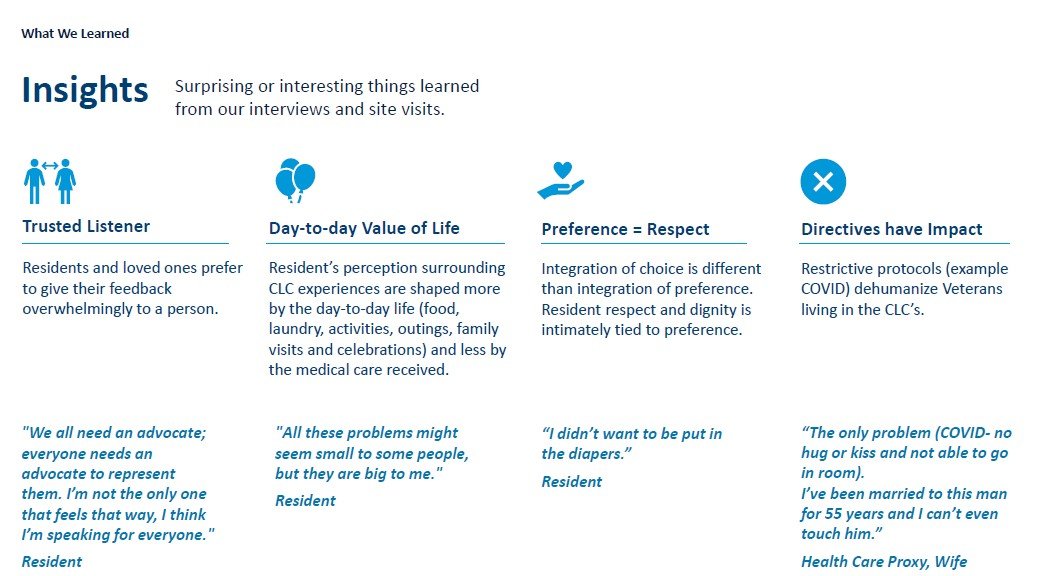
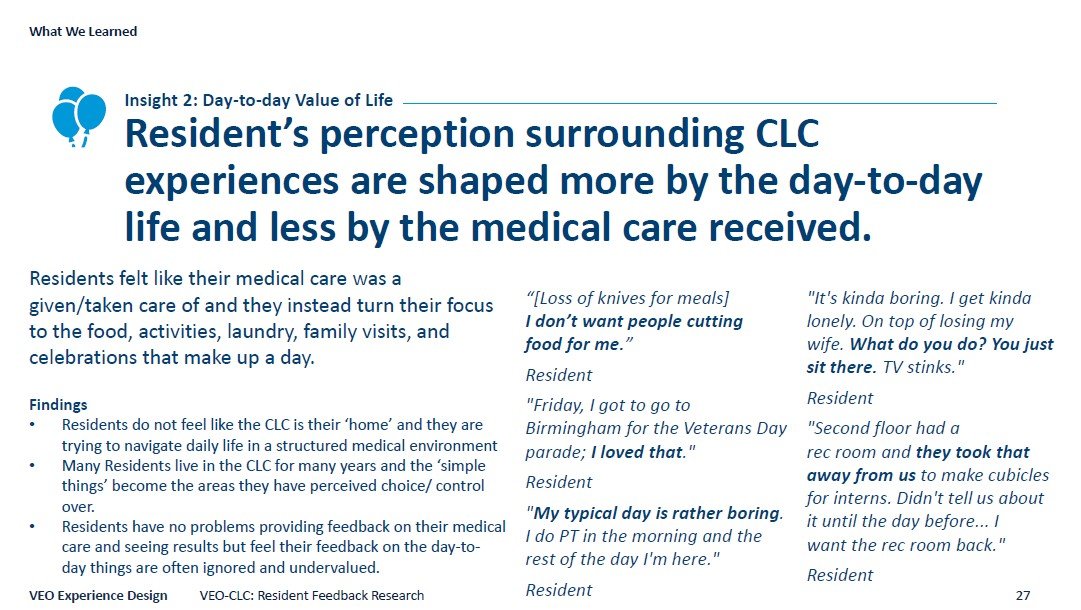
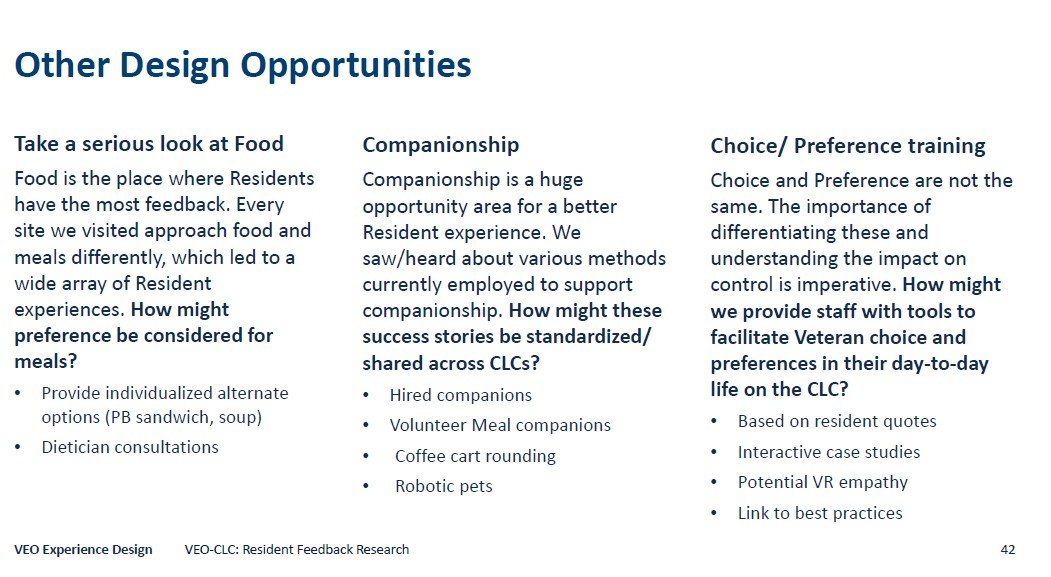
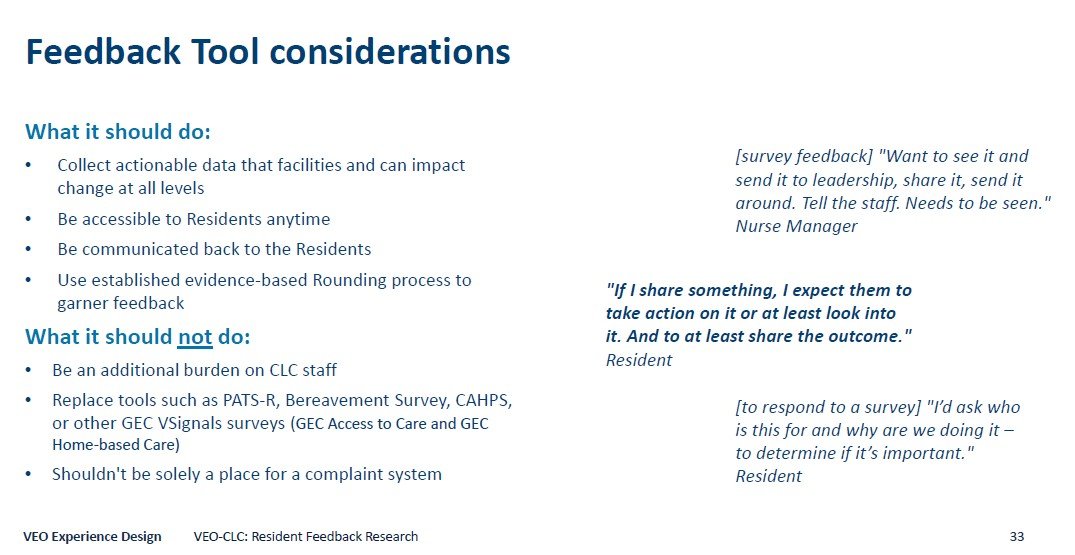
Million Veterans Program
Engaging Veteran to learn about Motivations to Participate
Overview
The Million Veteran Program (MVP) is a national voluntary research program partnering with Veterans to help researchers understand how genes affect health and illness.
MVP wanted to hear from Veterans to understand what they’ve found valuable and what may be valuable to them in the future as the program expands. This Human-Centered Design (HCD) project aimed to build capacity for MVP to engage with Veterans to collect feedback, garner ideas, and support long term efforts. To achieve this goal, the Veteran Experience Office (VEO) partnered with MVP to hold a prototype engagement session and develop an associated playbook to build a repeatable process for MVP to continue engagement and evolve their program.
Approach
Concept development: Collaboration with MVP, the team defined engagement types and activities as those that fall into one of two major categories to inform the playbook approach.
Participant recruitment: Intentional recruitment with an intersectional audience that MVP was hoping to reach to learn more from – BIPOC (Black, Indigenous, and People of Color) women veterans, under 40.
Prototype testing: Our teams held a prototype engagement session with Veteran participants and provided an engaging format for participants to share feedback and ideas.
Engagement Session Synthesis: The synthesis from our engagement session led to a valuable discussion with our stakeholders about the direction moving forward to engage Veterans and considerations for their program.
Outcomes
From our prototype testing workshop session with Veterans, we collected feedback to help improve future Veteran engagements/workshops as well as return of value opportunities for the Million Veterans Program. The participant group voluntarily chose to share their contact information with one another to stay connected after the workshop ended.
Deliverables
We developed a Veteran Engagement Playbook guide, a virtual Veteran Engagement session pilot, and a Feedback Report with learnings from the Playbook and session pilot.

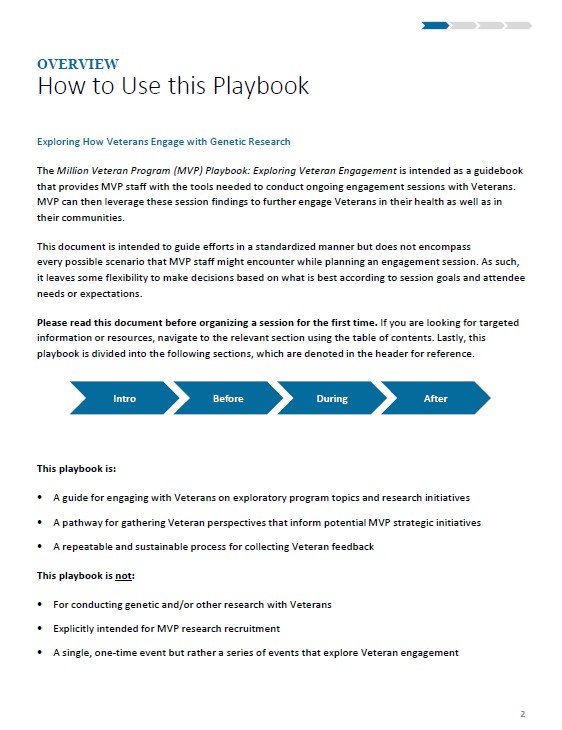
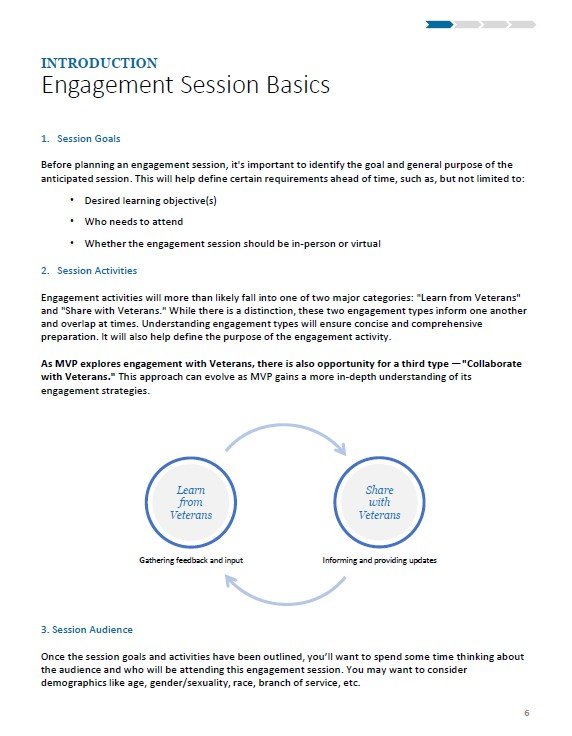
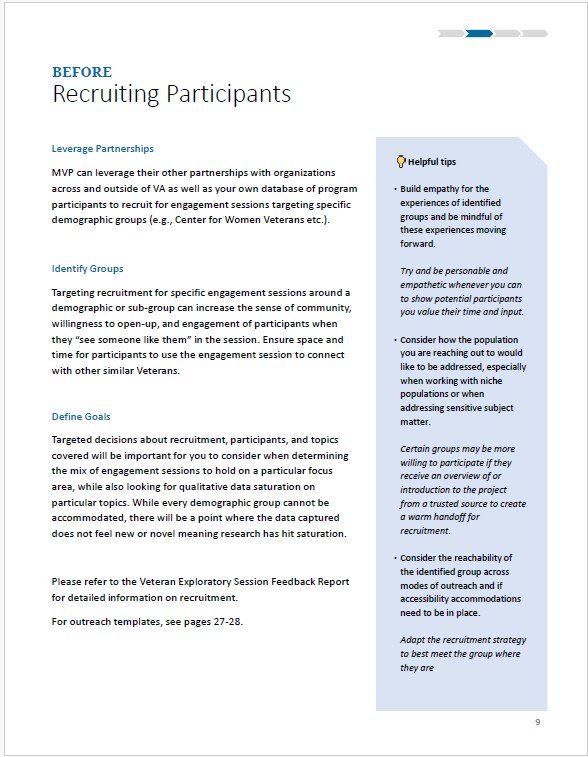


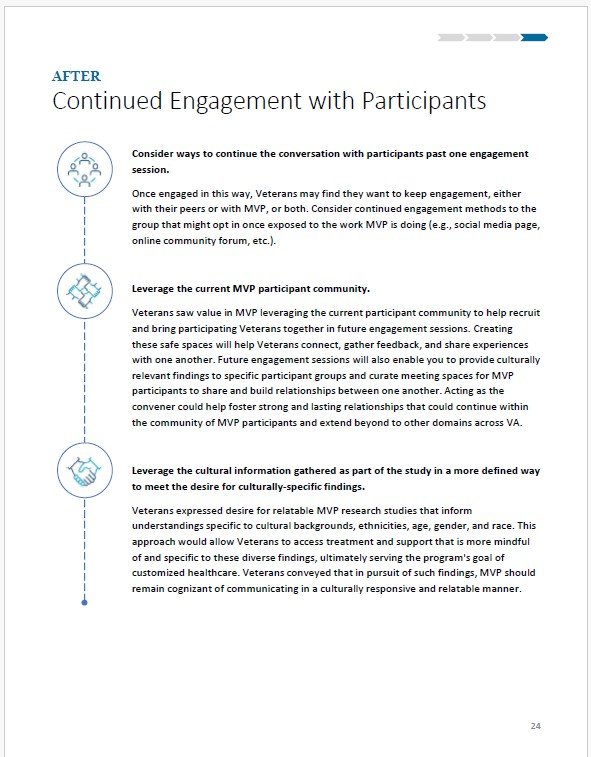
HCD process examples:
Was positioned into a new role as the Methods and Practice Lead
Led a new Problem Framing methodology and AI best practices in research for a stakeholder project
Design Practice Standards studio development -
Contractor/ New team member guide
Attended trainings for trauma-informed research with Jax Weschsler and the 2023 EPIC ethnography conference
Brought in team trainings – Improv for business with the Washington Improv Theater, Facilitation techniques with Lizard Brain Solutions
Veteran Participatory Workshop
Design pop‐up pilot
Overview
In my role as Methods and Practice Lead, I championed co-design practices and developed the pilot plan and execution for a participatory customer (Veteran) workshop that could ‘pop-up’ when needed to practice ideation, solution design, and prototyping with the customer. I wanted to ensure Veterans, Caregivers, Survivors, and their families are active collaborators in our work. The goal was to also strengthen partnerships across VA and foster a community that sustains HCD mindsets and skills beyond internal design projects and the VACXi classroom.
We partnered with the Center for Women Veterans (CWV) to pilot a design pop-up at an upcoming benefits and services outreach event in New York. The topic area and workshop approach were undefined when we accepted.
Approach
Concept development: I prioritized a data-driven approach that used multiple data sources with the support of our data team to create an analytics report that helped identify topic areas with opportunity gaps tailored to our women veteran population in a specific region where the pop-up was to be held.
Partnership: We were able to correlate the data-driven opportunity areas with strategic goals and initiatives that CWV had prioritized to make sure our pop-up focused high-level on relevant needs from our partner.
In-person Recruitment: Event constraints and a quick turnaround led us to recruit on-site just hours before the session start time. We were able to recruit 12 women Veterans in the NY/NJ region.
Future-focused prompt: We took a current opportunity area and crafted a workshop prompt that encouraged futures thinking and a strengths-based mindset to ideate and prototype. This deviated from the typical current-state, pain point mindset of other projects.
“Yes. I would like to participate in a session like this in the future. The session provided me an opportunity to hear other veterans experience and the information. I hope to help improve future program for other veterans. Thank you for the opportunity. It was nice to see people behind the organization.”
Outcomes
CWV used the insights from the Veteran workshop to continue and enhance two initiatives that were already underway in addition to desiring more Veteran design pop-ups in the future as a futures-thinking series. The team also briefed leaders across VA on the insights that related to their services. We also saw an opportunity to create a community of the women veteran participants to keep connected to one another and the work moving forward.
Deliverables
Insights report and pilot package, reusable workshop agenda and activities, post-session feedback survey, and evaluation plan
Community/ partnership examples:
Lead Moderator for the CX Strategist Federal Cohort, which includes CX Strategists across government agencies.
Developed community initiatives like a buddy program as well as leading discussions on topics such as research participant compensation, CX hiring, and best practices.
“Laura has demonstrated an exceptional understanding of HCD and ability to lead others through the process. She has led several successful projects and demonstrated masterful facilitation and stakeholder management this year in several projects. She was chosen as the cross agency CX Strategist community of practice lead ‐‐evidence of her being viewed as a leader in this field.
Laura is a leader in the CX Strategist pool and has demonstrated exceptional skills facilitating, designing visuals, agenda planning, conducting research and building stakeholder relationships. She is adept at knowing which approaches to use depending on the situation and advises others based on her experience.
Laura is exceptional at communicating and presenting information. She is a masterful facilitator and presenter. She continues to raise the bar on our team and to define what great facilitation practice is and looks/feels like.
She not only leads her projects to successful completion but also leads the Federal CX CoP to curate best practices and to connect with other CX strategists across government to share information and resources that are helping our Design team and the VACXi team elevate our design practice. She sees opportunities to improve the way we partner with contractors and has applied her expertise this year in designing and leading the development of the Contractor Welcome Guide that is helping to define our practice, communicate our expectations to partners and improve the way we team on projects.”





